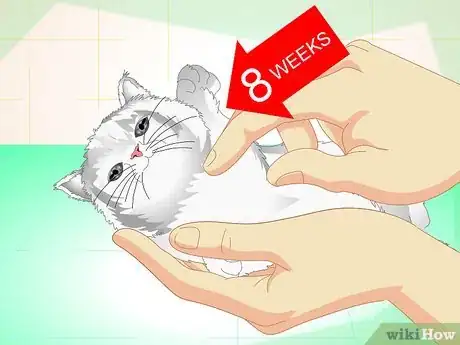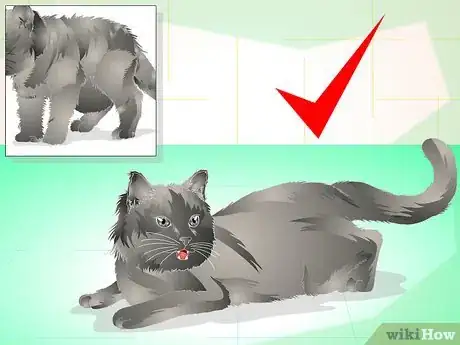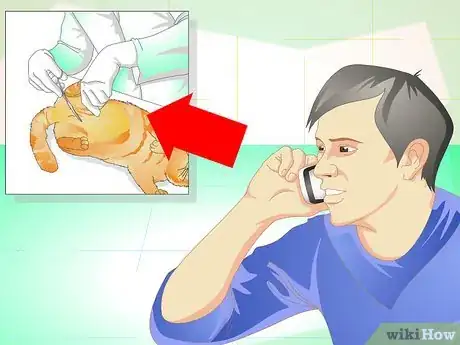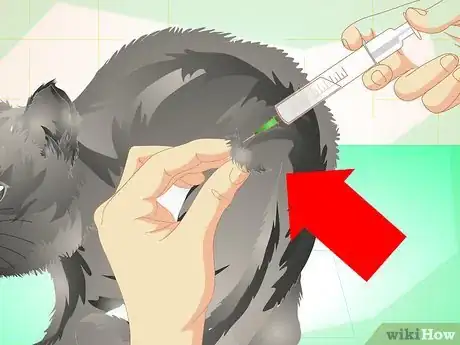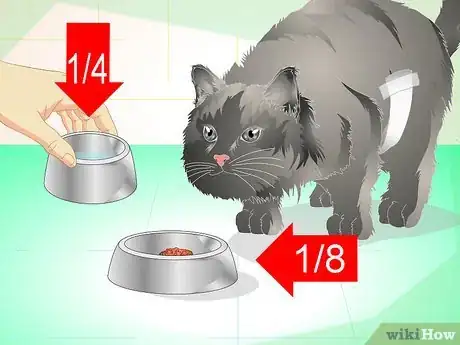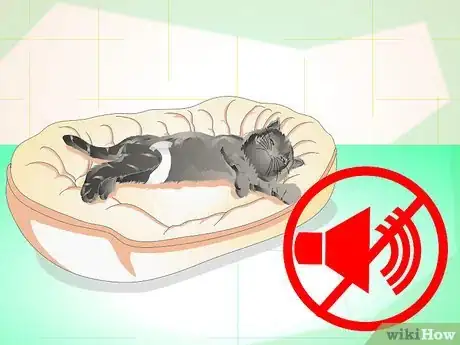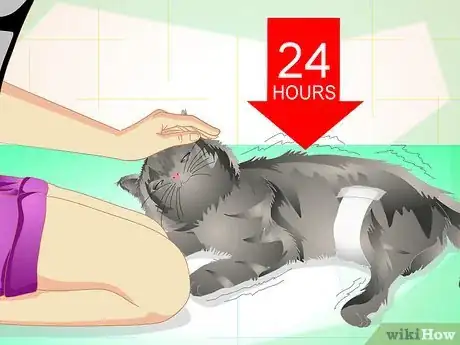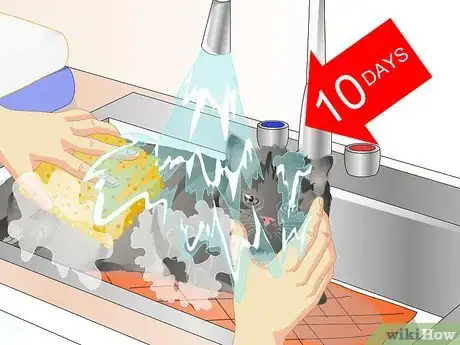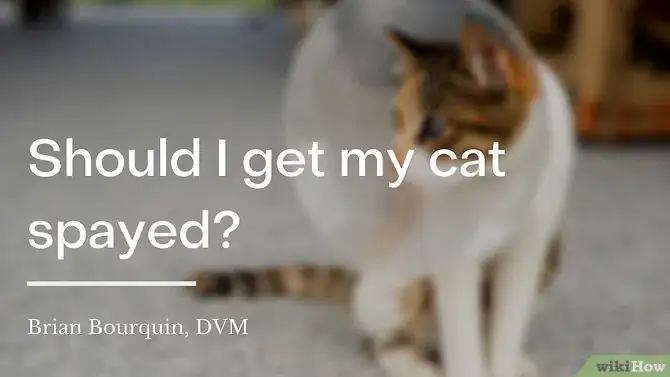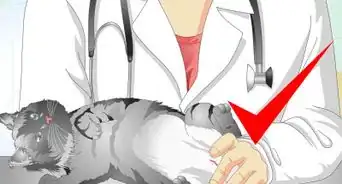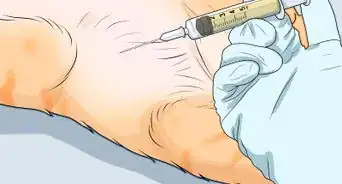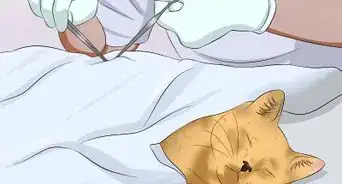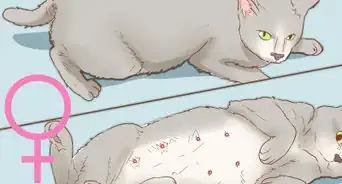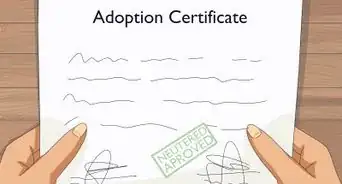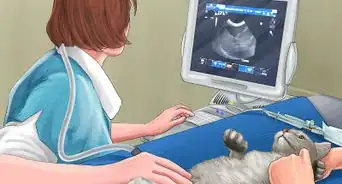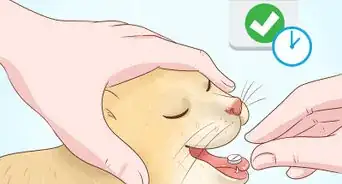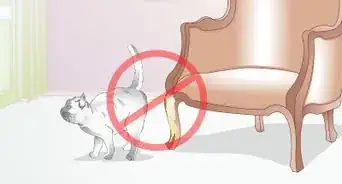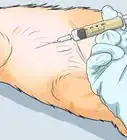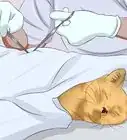This article was co-authored by Pippa Elliott, MRCVS. Dr. Elliott, BVMS, MRCVS is a veterinarian with over 30 years of experience in veterinary surgery and companion animal practice. She graduated from the University of Glasgow in 1987 with a degree in veterinary medicine and surgery. She has worked at the same animal clinic in her hometown for over 20 years.
There are 9 references cited in this article, which can be found at the bottom of the page.
This article has been viewed 31,540 times.
Getting your cat spayed is a good idea for both your cat and the general cat population. Spaying your cat will ensure she’s not able to contribute to the unfortunately large unwanted cat and kitten population. Plus, spayed cats are less likely to develop uterine infections and breast cancer. If she’s spayed before she’s ever able to go into heat, you’ll never have to experience the crazy yowling she might make, and you’ll won’t have to worry about her urinating all over your house.[1]
Steps
Getting Your Cat Spayed
-
1Spay kittens as early as 8 weeks. If you have a litter of kittens, they can be spayed as early as 8 weeks old. If you are adopting a kitten from a rescue or shelter, they will usually spay her before she goes home with you, especially since kittens shouldn’t be taken away from their mothers until they are at least 8 weeks old.[2]
- In addition to your cat being at least 8 weeks old, she should also be at least 2 pounds in weight, before she’s spayed.[3]
- In order to avoid your cat going into heat, you should get her spayed before she’s 5 months old (unless there are medical reasons why she can’t go for surgery).
-
2Take a cat in heat for a spay surgery. If a cat is already in heat, or even if she’s pregnant, a spay can still be performed. However, a veterinarian would need to examine the cat and determine how far along she is with her pregnancy before it’s decided if a spay is safe.[4] [5]Advertisement
-
3Consider spaying your older cat. Cats can be spayed at any age. However, cats who are older than 7 years of age may need to have pre-surgical blood tests completed to determine if sedation (and therefore surgery) is safe.[6]
-
4Look for low-cost spay clinics. A spay surgery can be quite pricy if you have a low or limited income. However, there are a lot of spay and neuter programs available all over North America that offer low-cost or free surgeries.[7]
- Speak to your veterinarian about what programs may be available in your area.
- Call your local SPCA, Humane Society, cat shelter, or cat rescue to ask if they know of any local programs.
- Use the search program on the following website — http://www.humanesociety.org/issues/pet_overpopulation/tips/afford_spay_neuter.html — to find a program based on your zip code or city and state info.
-
5Make an appointment for your cat’s surgery. Whether you decide to take your cat to your veterinarian or a spay/neuter clinic, you’ll have to book the appointment in advance. Some clinics or veterinarians may want to examine your cat before they perform surgery, especially if you cat has never been to that vet/clinic before. In many cases the surgeon will conduct the exam immediately before the spay surgery. If the surgeon finds any issues, the surgery won’t be perform that day. If the surgeon doesn’t find any issues, the surgery will continue as planned.
- If the surgeon discovers any issues that prevent the surgery from being conducted, they will contact you to discuss. Most of the reasons for denying surgery are relatively minor (e.g. your cat has a fever or hasn’t overcome a previous illness or infection yet) and will simply require waiting a little while before performing the surgery.
- Many spay/neuter clinics will require proof of vaccination prior to performing the spay surgery. If the clinic doesn’t have this information already on file, make sure you bring a paper copy with you to the spay appointment.
-
6Take food away from your cat the night before surgery. A cat’s spay surgery does require your cat to go under anaesthetic. Because of this, you should take your cat’s food away starting the night before her surgery, or, if the surgery is in the afternoon, approximately 3-4 hours before surgery. She can, however, continue to drink water.[8]
- If you’re getting a kitten spayed, ask the veterinarian if she needs to stop eating before surgery. Depending on her age, she may need to continue eating right up until her surgery.
- If you have more than one cat or kitten, you may want to isolate the one being spayed so the other cats can continue to eat.
- Anesthetic can cause nausea and vomiting, which can actually kill a sedated cat, so it’s best if your cat’s stomach is empty during surgery.
-
7Bring an outdoor cat inside before surgery. If you’re taking a feral or stray cat for a spay surgery, or if your cat normally goes outside on a regular basis, it is best to bring her inside the night before the surgery is to be performed.
-
8Transport your cat to her surgery in a carrier. When taking your cat into the clinic for her surgery, make sure she’s inside a carrier. Depending on her age and experience at a vet’s office, she may be nervous and stressed — having her inside a carrier gives her a safe and comfortable spot to wait for her surgery.[9]
- You may need to leave the carrier at the clinic while your cat is having her surgery. Or you will be asked to bring it back with you when you come to pick her up.
Taking Care of Your Cat Immediately After Surgery
-
1Provide your cat with pain medication. Your veterinarian may prescribe a pain medication for your cat after her surgery. If a medication is provided, follow the instructions as to when and how to give them to your cat.
- Do not, under any circumstances, give your cat human pain medications. Many of these can be toxic to your cat and will do more harm than good.
- Most cats receive pain medication during surgery, which can take up to 24 hours to wear off.
-
2Give your cat a small amount of food and water. When you bring your cat home immediately after her surgery, she probably won’t be too hungry. You can give her about ⅛ cup of food and a ¼ cup of water right away. If she eats and drinks it, and she’s able to keep it down, you can provide her with more food and water.[10]
- Do not provide your cat with unlimited food and water immediately after her surgery. Even if she’s hungry, too much food and water may cause stomach upset.
- If you cat doesn’t eat or drink the night after her surgery, there’s nothing to be concerned about. Contact your veterinarian if you cat doesn’t start eating again the day after her surgery.
-
3Give your cat a quiet place to recover. After your cat has been spayed, she may not feel very good and she will most likely want to crawl into a corner and ignore the world. In order to allow her to do this comfortably, give her a quiet space in your home all to herself.[11]
- If you have more the one animal, you’ll want to make sure this location is blocked off so the other animals cannot disturb your recovering cat.
- Putting her alone in a bathroom or bedroom, with a comfy place to sleep, as well as litter, are two good places to consider.
-
4Stay calm if your cat is shaking or trembling. When the anesthetic is wearing off, your cat may shake or tremble a little bit — this is perfectly normal and shouldn’t last more than 24 hours. If you cat is still shaking or trembling after 24 hours, contact your veterinarian.[12]
-
5Watch your cat for other signs of illness. A spay surgery shouldn’t have any long-term negative effects on your cat. If you cat shows any of the following symptoms, it can be a sign of a complication which will need to be checked by a veterinarian.[13]
- If your cat is acting lethargic or is sleeping a lot more than usual.
- If your cat cat isn’t eating or drinking very much.
- If your cat is suffering from diarrhea or is vomiting a lot.
Helping Your Cat Recover Completely
-
1Look for your cat to be back to normal in 48 hours. For most cats, the surgery doesn’t cause any long-term negative symptoms. In fact, most cats will be back to “normal” within 48 hours of surgery. If your cat isn’t back to “normal” within 2-3 days, contact your veterinarian.[14]
-
2Check the site of the incision. Part of your daily routine, after your cat’s been spayed, is to check her incision to make sure it’s healing properly. You’ll want to make sure the incision itself is binding and healing, and that it doesn’t look red or inflamed (and therefore infected) or has any discharge. If the incision isn’t healing, or looks infected, contact your veterinarian.[15]
- Look at your cat’s incision the day you take her home, this is what a normal, healing incision should look like. You can use this as a basis for watching her incision for the next few weeks. If it never changes, gets red in colour, becomes inflamed, or something starts to leak out, you’ll need to contact your veterinarian.[16]
- The incision should heal substantially within 7 to 10 days. After this time the incision should be able to hold up against stretching and pulling.[17]
- Note — incisions heal from side-to-side, not end-to-end, therefore a longer incision doesn’t take longer to heal than a short incision.
-
3Stop your cat from running and jumping. Your vet may recommend that you keep your cat from running and jumping up to 2 weeks after she’s been spayed. An adult cat may not feel like doing this right after surgery anyway, so it may be easy to restrain her. A kitten, however, may be difficult to restrain, but will also likely bounce back from surgery faster.[18]
- If you do need to keep your cat from running and jumping, she’ll need to be placed somewhere in your home where there aren’t a lot of places to jump up on, and not a lot of room for running. A bathroom or bedroom might work well.
- If your cat has a tall scratching post, window seat, or cat condo, you may need to put them away until your cat is fully healed.
-
4Do not allow your cat to lick her incision excessively. You cat may be tempted to clean and lick the site of her incision, especially if it becomes itchy. An occasional cleaning shouldn’t be a problem, as long as she doesn’t spend a lot of time cleaning the area. If, however, she is constantly licking the area of her incision, you’ll need to put a special collar on her.[19]
- The formal name of this collar is the Elizabethan collar. The casual name you’ll hear more often is the “cone of shame”!
-
5Wait at least 10 days before giving your cat a bath. In general, cats don’t need to be bathed very often. However, if you do need to give your cat a bath after she’s had surgery, you should wait at least 10 days.[20]
Should I Get My Cat Spayed?
Expert Q&A
-
QuestionShould I get my cat spayed?
 Brian Bourquin, DVMBrian Bourquin, better known as “Dr. B” to his clients, is a Veterinarian and the Owner of Boston Veterinary Clinic, a pet health care and veterinary clinic with three locations, South End/Bay Village, the Seaport, and Brookline, Massachusetts. Boston Veterinary Clinic specializes in primary veterinary care, including wellness and preventative care, sick and emergency care, soft-tissue surgery, dentistry. The clinic also provides specialty services in behavior, nutrition, and alternative pain management therapies using acupuncture, and therapeutic laser treatments. Boston Veterinary Clinic is an AAHA (American Animal Hospital Association) accredited hospital and Boston’s first Fear Free Certified Clinic. Brian has over 19 years of veterinary experience and earned his Doctor of Veterinary Medicine from Cornell University.
Brian Bourquin, DVMBrian Bourquin, better known as “Dr. B” to his clients, is a Veterinarian and the Owner of Boston Veterinary Clinic, a pet health care and veterinary clinic with three locations, South End/Bay Village, the Seaport, and Brookline, Massachusetts. Boston Veterinary Clinic specializes in primary veterinary care, including wellness and preventative care, sick and emergency care, soft-tissue surgery, dentistry. The clinic also provides specialty services in behavior, nutrition, and alternative pain management therapies using acupuncture, and therapeutic laser treatments. Boston Veterinary Clinic is an AAHA (American Animal Hospital Association) accredited hospital and Boston’s first Fear Free Certified Clinic. Brian has over 19 years of veterinary experience and earned his Doctor of Veterinary Medicine from Cornell University.
Veterinarian
Warnings
- Spaying a cat can lower her metabolism, which may mean you do not need to feed her as much for her to maintain a decent weight. However, it is a myth that spaying a cat automatically leads to her being overweight. The average cat becomes overweight because she’s given too much food or treat, or because she doesn’t get enough exercise.[22]⧼thumbs_response⧽
- Paediatric spays, which are spays performed when the cat is under 5 months old, are perfectly safe and many veterinarians recommend this. However, a kitten as young as 2 months does run the risk of getting hypothermia while she’s sedated. Because of this, veterinarians who perform paediatric spays will use a slightly different sedation technique than they would with older cats.[23]⧼thumbs_response⧽
References
- ↑ https://www.aspca.org/pet-care/general-pet-care/spayneuter-your-pet
- ↑ https://www.aspca.org/pet-care/general-pet-care/spayneuter-your-pet
- ↑ http://humanesocietyofcharlotte.org/clinic-services/clinic-srvicesmyths-and-truths-about-spayneuter/
- ↑ https://www.aspca.org/pet-care/general-pet-care/spayneuter-your-pet
- ↑ http://humanesocietyofcharlotte.org/clinic-services/clinic-srvicesmyths-and-truths-about-spayneuter/
- ↑ http://humanesocietyofcharlotte.org/clinic-services/clinic-srvicesmyths-and-truths-about-spayneuter/
- ↑ http://www.humanesociety.org/issues/pet_overpopulation/tips/afford_spay_neuter.html
- ↑ https://www.aspca.org/pet-care/general-pet-care/spayneuter-your-pet
- ↑ http://www.seattle.gov/animal-shelter/spay-and-neuter/pre-surgery-instructions
- ↑ http://www.oneofakindpets.com/site/our-clinic/pre-post-operative-instructions/
- ↑ https://www.aspca.org/pet-care/general-pet-care/spayneuter-your-pet
- ↑ http://www.oneofakindpets.com/site/our-clinic/pre-post-operative-instructions/
- ↑ https://www.aspca.org/pet-care/general-pet-care/spayneuter-your-pet
- ↑ http://www.oneofakindpets.com/site/our-clinic/pre-post-operative-instructions/
- ↑ https://www.aspca.org/pet-care/general-pet-care/spayneuter-your-pet
- ↑ https://www.aspca.org/sites/default/files/upload/images/caring-for-your-cat-or-dog-after-surgery-1.pdf
- ↑ http://www.peteducation.com/article.cfm?c=2+2116&aid=3025
- ↑ https://www.aspca.org/pet-care/general-pet-care/spayneuter-your-pet
- ↑ https://www.aspca.org/pet-care/general-pet-care/spayneuter-your-pet
- ↑ https://www.aspca.org/pet-care/general-pet-care/spayneuter-your-pet
- ↑ http://www.sheltermedicine.vet.cornell.edu/Resources/Tattoo.cfm
- ↑ http://www.peteducation.com/article.cfm?c=1+2235&aid=908
- ↑ http://www.peteducation.com/article.cfm?c=1+2235&aid=908
About This Article
To get your cat spayed, wait until it's at least 8 weeks old if it's a kitten. Then, make an appointment with your vet, and stop feeding your cat the night before the surgery. If your cat is already pregnant or in heat, get it examined by the vet to see when it can be spayed. When you're ready to take your cat to its appointment, transport it in a carrier so it has a safe space if it's feeling stressed. After the operation, follow the vet's instructions, which may include giving your cat pain medication. For more tips on how to care for your cat after getting it spayed, keep reading!
